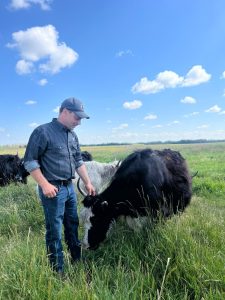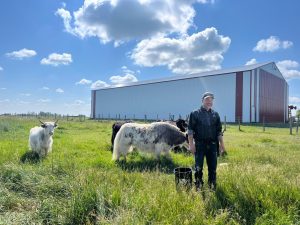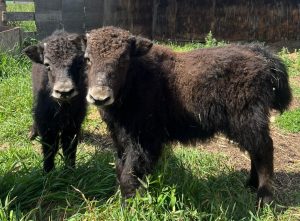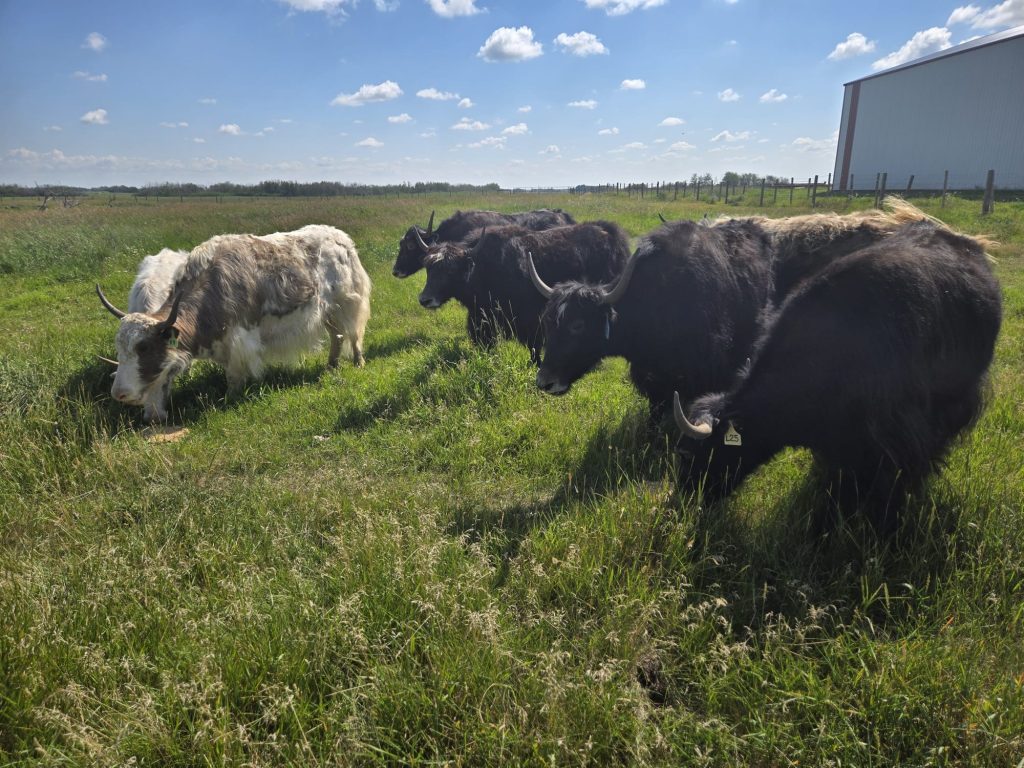Raising Yaks

Our first question had to be “why did you choose yaks?” According to Dave, yaks are relatively easy calving and they’re built for intense winters, so they’re suited to this region. Having little experience with livestock before, he was looking for something a bit different and just felt yaks would be a good fit. Dave started with 20 animals about ten years ago, and before long he’d doubled his herd. Today, with calves included, his herd numbers around 150.
Raising yaks in Alberta might sound a little out there, but Dave’s experience shows they’re well suited to the climate. “They’re built for the cold. Calving’s easier too — a full-grown female is about 600 to 700 pounds, and the calves are only around 25 pounds, so really tiny.” This means calving season for Dave is relatively low stress — something many cattle producers would wish for!
It’s not just their resilience that appeals to Dave, the yaks have character. “I can’t quite put into words what they’re like, and each individual is different, but they’ve got more personality than cattle for sure.”
From Farm to Table
We also wondered what Dave does with the meat, it’s not like yak is something we see everyday on the supermarket shelves! He told us that he sells some meat locally, through word of mouth, and has some regular customers. Otherwise, his meat goes to the Alberta Wapiti Products Cooperative Ltd, which specialises in selling yak and elk meat to a wider market, through Wapiti River and Prairie Heritage Meats.
“It’s lean like bison, but tastes more like beef,” he explains. “And it’s a bit slower to mature. I usually butcher at three years old.”
In addition to meat, there’s potential in the fibre — yak wool is fine and soft, but processing it is labour intensive. Each yak needs combing once they start shedding, but they don’t all shed at the same time so it’s unpredictable work. Dave told us he’s sold a little raw fibre, but it’s not a major focus for his operations.
Polyculture Trials and Building Soil

Dave’s interest in regenerative agriculture started with a desire to do more with his soil. “Instead of mining the soil every year, I want to build on what I did the year before. Try to get more out of the land over time.”
That curiosity led him to the Regenerative Agriculture Lab’s (RAL) polyculture trials. First hearing about them from our project manager Shiana, he decided to give polycultures a try.
His first year was a success. “There was a lot of biomass. The brassicas especially were amazing. I had my bulls grazing on it and while they didn’t love the brassicas, it grew really well.”
This season, things haven’t gone quite so smoothly. Dave’s polyculture plot has been less productive this year. Wondering why this might be the case, he thinks one contributing factor might have been that it was too dry when he seeded the plot, resulting in poor germination and lack of moisture to get the plants started.
Despite running into challenges, he’s not giving up. “I’m still interested in polycultures. I’ve learned some blends just don’t work well here. Like millet — one year it grew, but most years, it hasn’t. So now I’m getting more selective, trying to use what I know grows well in this area.”
For Dave, polycultures offer flexibility — a way to add forage when grass has ended its life-cycle and extend grazing into fall. “Yaks build up fat reserves in the fall, so having more nutritious forage that time of year helps them go into winter in better condition. That means I can cut back on winter feed” making polycultures economically appealing as well and a great tool for creating high quality feed in the fall.
Finding the Balance
Like many producers experimenting with regenerative practices, Dave finds balancing the risks tough. He faces a push and pull between trying more regenerative practices — and facing the unknown — and sticking with long-standing conventional methods that offer more stability. It’s a balancing act — weighing risk, weather and economics against long-term soil health and resilience.
What’s helped him so far is the power of community. Being part of the Regenerative Agriculture Lab’s polyculture trials has opened up space for conversations. Dave shared the importance of his network of other producers on the same journey — testing, tweaking and sometimes failing, just like he is. Whether it’s getting advice on which no-till drill to buy or figuring out the right blend for forage, they help each other along.
“It’s just reassuring that people are trying the same things you are, people you can call and troubleshoot things with once you know who’s in your circle.”
A Gradual Shift
 Dave’s approach to regenerative agriculture is thoughtful, practical and grounded in trial and error. Aside from the polyculture trials, he’s seeded some of his other crops with rye or triticale to maintain living roots and provide early or late-season grazing. He has experimented with intercropping growing canola and lentils together. He’s also made his own blends for different parts of the farm. “I’ve tweaked them over time. I spoke to Kevin Elmy at a conference and realized maybe the rye I’d added was suppressing other species. So I switched to triticale instead.”
Dave’s approach to regenerative agriculture is thoughtful, practical and grounded in trial and error. Aside from the polyculture trials, he’s seeded some of his other crops with rye or triticale to maintain living roots and provide early or late-season grazing. He has experimented with intercropping growing canola and lentils together. He’s also made his own blends for different parts of the farm. “I’ve tweaked them over time. I spoke to Kevin Elmy at a conference and realized maybe the rye I’d added was suppressing other species. So I switched to triticale instead.”
His advice to other producers interested in shifting their agricultural practices? Don’t give up if something doesn’t work the first time. Stick with the regenerative principles but adjust things to your land, your soil and your situation.
Looking Ahead
Looking ahead, Dave isn’t planning a dramatic overhaul — just steady progress. He hopes to keep deepening his regenerative practices, refining his blends and learning what works best on his land. The yak herd has likely reached its ideal size, but he’s open to sharing what he’s learned with others curious about raising these unique animals.
What keeps him going isn’t a single moment or breakthrough, but the slow build — the idea that each season brings a chance to learn, adjust and care for the land in a better way. It’s not about chasing perfection, but about staying curious and connected.
If you’re wondering how polycultures might fit into your own farm or want to learn more about yaks and their place on the prairie, don’t hesitate to reach out. Dave’s happy to share his experience — and the Regenerative Agriculture Lab is always looking for more folks to join the conversation.
For more information about the Alberta Polyculture Trials visit our webpage.

—

